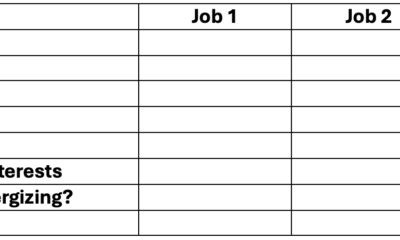Teamwork
4 Types of Organization Culture in Business

Different types of organizational culture can make or break your company’s success. They have the power to turn a good business into a great one or hold it back from reaching its full potential.
Imagine walking into two different companies—one is buzzing with energy, collaboration, and shared purpose, and the other is stagnant, disconnected, and demotivating. The difference? Organizational culture.
Understanding the unique types of organizational culture is essential regardless of what type of company you’re running.
This guide will help you decode the four types of organizational culture that are most common in today’s fast-paced business world. You’ll learn all about what organizational culture is, what the four types of organizational culture are, why it matters, and what you can do to better your own company’s culture.
What is Organizational Culture?
Organizational culture refers to shared values, practices, and attitudes of those in your company, and it impacts every aspect of your business. From employee motivation and satisfaction to your financial success, organizational culture is a vital part of your business.
A 2022 study from OnHires found that 77% of adults evaluate company culture before applying for a job. Likewise, 84% of recruiters say that matching the type of organizational culture to what the applicant is seeking is a key factor when recruiting.
In an episode of the Team Building Saves the World podcast, Chief of Culture & Community at New Level Work Wendy Hanson shared her own insights on applicants showing interest in company culture. She said that today’s applicants will pose direct questions like:
“Tell me about the culture in this company. You know, what does it look like?”
The Culture of an Organization Isn’t the Mission Statement
Sometimes, organizational culture is confused with a company’s mission statement or goals, but they’re not the same thing. Your mission statement and goals may be related to your company culture, but your culture is something separate.
A better indicator of your company culture is how people react to different situations. For example, how you adapt to changes in customer demand, how a manager responds to employee questions, or how a CEO navigates a crisis.
What Are the Four Types of Organizational Culture?
There are four main types of organizational culture, and each of them has its own pros and cons. Understanding each of these will help you make a more informed decision about which one is best for you, so let’s take a closer look at them
1. Clan Culture
As the name suggests, clan culture is a very people-oriented culture that places an emphasis on teamwork, collaboration, and communication. It often gives the company a family-like vibe that encourages employees to work together, communicate with higher- and lower-level staff members, and be flexible.
This type of organizational culture is most common in smaller companies such as start-ups since the family-like setup works best with smaller teams. Team building activities are also common since they encourage employees to bond, communicate, and work together.
Strengths of Clan Culture
-
- High employee satisfaction, engagement, and morale.
-
- Adaptable and flexible.
-
- Very collaborative, which can drive innovation and success.
Weaknesses of Clan Culture
-
- Difficult to use in larger organizations.
-
- We may need more direction in the long term.
-
- Requires lots of involvement to keep going.
2. Adhocracy Culture
Adhocracy culture is much more focused on taking risks and innovating than clan culture. Companies with this organizational work culture place a high value on creativity, individuality, and ideas. They encourage employees of all positions to share their ideas and help push the company forward, constantly adapting to the current market.
These companies often have brainstorming sessions, inviting employees to bring their creativity to the table. Big tech companies frequently use this model since they’re focus is on coming up with the best new tech possible.
Strengths of Adhocracy Culture
Weaknesses of Adhocracy Culture
-
- Risks have the potential not to pan out
-
- Can create competition between employees.

3. Market Culture
Market culture is one of the more traditional types of organizational culture in business. This option places most of the emphasis on profit margins and growth. Companies with a market culture are focused on the bottom line and their ROI (return on investment).
Employees each serve their specific role in the greater organization, and there is a clear separation between lower-level employees and management. These companies are highly focused and driven towards their goal of higher profits.
Strengths of Market Culture
-
- Highly profitable.
-
- Focused towards a clear, unified goal.
Weaknesses of Market Culture
-
- Risk of employee burnout.
-
- Employees may end up not feeling valued.
-
- Potential for poor work-life balance.
4. Hierarchy Culture
Hierarchy culture is what many think of as the most classic of the organizational culture types. Companies with a hierarchy culture have a boss at the top and a clear chain of command all the way down.
With the rise of remote work and virtual teams, organizational cultures may need to adapt to accommodate flexible work schedules and communication methods. This shift can lead to a more inclusive and diverse work environment, but it may also present challenges in maintaining company culture and cohesion.
Emphasis on Diversity and Inclusion
There is a growing emphasis on diversity and inclusion in the workplace, and this will likely continue to shape organizational culture in the future. Companies that prioritize diversity and create inclusive environments tend to have higher employee engagement and better overall performance. This focus on diversity and inclusion can lead to a more innovative and progressive organizational culture.
Focus on Employee Well-being
Employee well-being is becoming an increasingly important aspect of organizational culture. Companies that prioritize the health and happiness of their employees tend to have higher retention rates and improved productivity. In the future, we may see a shift towards more holistic approaches to employee well-being, including mental health support, flexible work arrangements, and wellness programs.
Overall, the future of organizational culture is likely to be shaped by a combination of technological advancements, changing attitudes towards diversity and inclusion, and a focus on employee well-being. Companies that adapt to these trends and prioritize creating a positive and supportive work culture will be better positioned to attract and retain top talent in the future.
The Growing Demand for Remote Work
A recent 2022 SHRM survey of 1,700 workers revealed that 48% of respondents are actively seeking opportunities to work remotely in their next job. This significant percentage highlights a shift in workplace preferences that will undoubtedly influence organizational cultures moving forward.
The Globalized Landscape
Advancements in technology have propelled our society into a more interconnected and globalized era. Companies are increasingly embracing remote work arrangements, hiring talent from diverse geographical locations, and expanding their operations internationally. As a result, organizational cultures must adapt to accommodate a variety of cultural norms and practices from around the world.
Building a Strong Organizational Culture
Organizational culture plays a pivotal role in shaping interactions, decisions, and overall outcomes within a business. Now is the opportune moment to cultivate the culture you envision for your teams, whether it involves reinforcing existing dynamics or instigating a transformative shift within your company.
If you’re looking to enhance your organizational culture, TeamBonding offers a range of team building programs and events designed to help you assess and enhance your workplace culture. Reach out to us today to leverage your company culture as a competitive advantage.
-

 Professional Development1 month ago
Professional Development1 month agoDrawing up your strategy
-

 Personal Growth2 months ago
Personal Growth2 months agoSucceeding as a ‘parentpreneur’: Top tips
-

 Videos2 months ago
Videos2 months agoGreat Leaders INSPIRE Others To Do Great Things
-

 Productivity1 month ago
Productivity1 month agoHow to Increase Remote Work Productivity
-

 Productivity2 months ago
Productivity2 months agoTips for Boosting Work Productivity
-

 Productivity2 months ago
Productivity2 months ago5 Ways to Increase Your Personal Assistant’s Productivity
-

 Leadership1 month ago
Leadership1 month agoHow to Tackle Big Challenges
-
Leadership1 month ago
Cutting Through the Clutter of Internal Communications



























